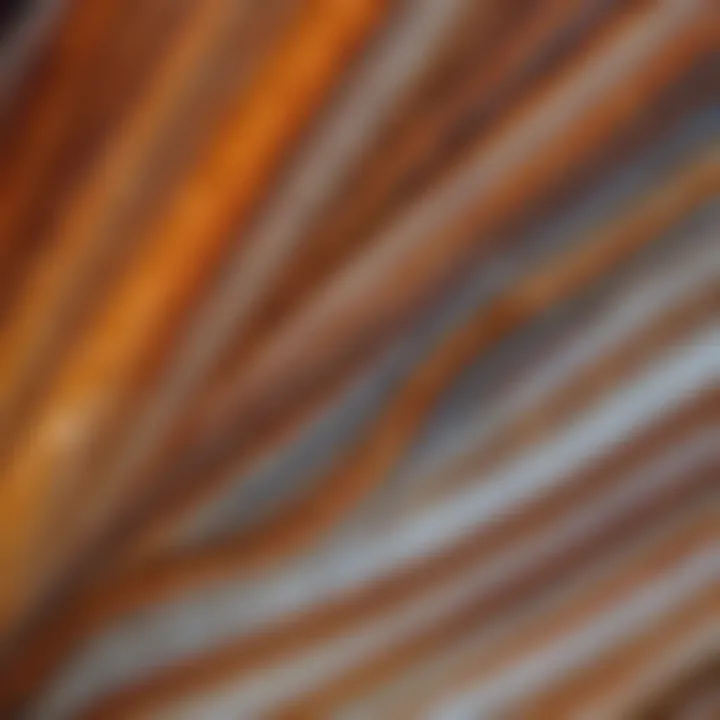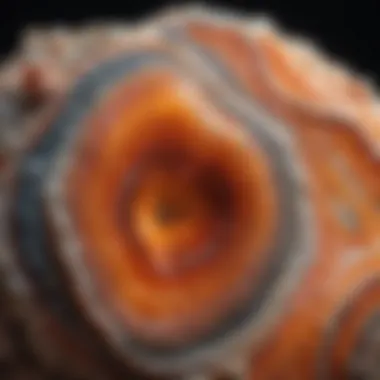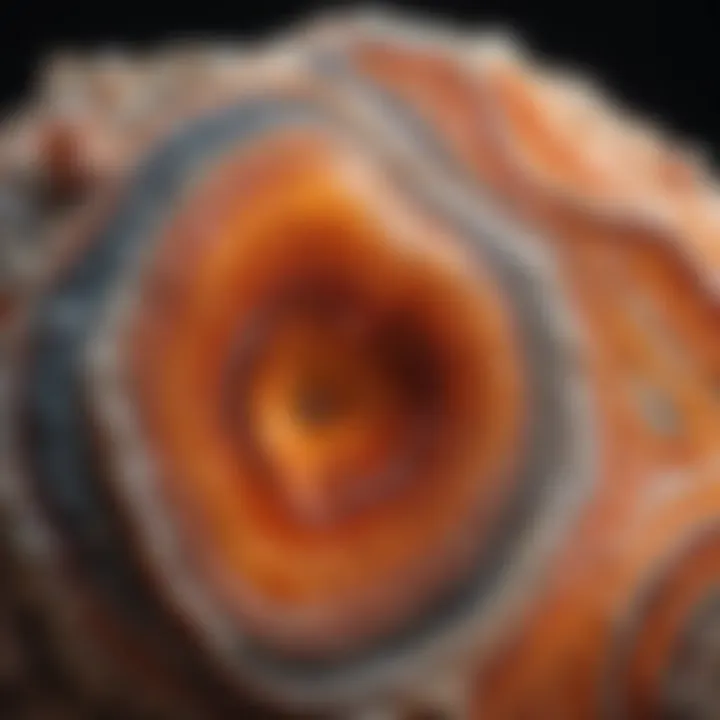Exploring the Intricacies of Valuable Agates


Intro
Agates are one of the most fascinating and prized minerals among collectors and enthusiasts. Their allure extends beyond mere aesthetics; they embody a rich geological history and provide insight into the Earth’s processes. Collecting agates not only connects individuals to nature but also to a broader community. This section addresses the essential aspects that make agates valuable, including their formation, features, and significance.
Featured Collectible of the Month
Overview
This month, we spotlight the striking Botswana agate. Renowned for its distinct banded patterns and subtle color transitions, Botswana agate captivates collectors worldwide. It typically features gray, cream, and hints of pink hues that create a unique visual harmony. This type of agate is not just valued for its beauty; it also represents the geological history of its origin, making it an interesting specimen for analysis.
Historical Significance
Botswana agate, primarily found near the Botswana and South Africa border, has a rich cultural relevance. Traditionally, local tribes considered it a protective stone, believing it to have healing and grounding properties. Its cultural ties add a layer of significance to its collection, attracting both geologists and those interested in its mystical past. The demand for this agate continues to rise, impacting both its market value and availability.
Identification Techniques
For collectors, identifying agates requires a keen eye and understanding of specific features.
Visual Characteristics
To properly identify agates, collectors should pay attention to the following characteristics:
- Color Patterns: Examine the bands for consistency and unique shading.
- Transparency: Agates typically range from opaque to semi-transparent.
- Surface Texture: Look for smooth surfaces; rough or pitted areas might indicate imperfections.
- Size and Shape: Specimens vary greatly; however, larger, well-formed pieces tend to be more valuable.
Resources for Identification
Several resources can aid in the identification of valuable agates:
- Books: Literature such as "Agates of North America" offers in-depth descriptions and pictures.
- Online Communities: Websites like reddit.com and forums may provide visual references and members' opinions.
- Local Gem Shows: Events allow collectors to interact with experts and observe agates in person.
Understanding agates involves both appreciating their beauty and recognizing their unique geological narratives. Knowledge of their identification techniques and historical importance strengthens the collector's experience. Each piece tells a story, making agate collecting a rewarding pursuit.
Prologue to Agates
Agates are more than mere rocks; they represent a fascinating intersection of beauty and geological significance. Understanding these unique formations plays a crucial role in appreciating their value—not just as decorative pieces but also as objects of scientific interest. This section aims to lay the groundwork for the subsequent exploration of agates, detailing their definition and the geological processes behind their formation. In doing so, readers can better understand the characteristics that make certain agates more desirable in the world of collecting.
Definition and Characteristics
Agates are a variety of chalcedony, a form of silica, known for their distinctive banded patterns and vibrant colors. They develop in volcanic or metamorphic rocks, often forming in hollow spaces, or geodes. The word agate originally comes from the Achates River in Sicily, where these stones were first found.
Key characteristics of agates include:
- Banding: The most recognizable feature is their layered appearance, which can vary from delicate, thin bands to broad, dramatic swathes.
- Color Variety: Colors can range from vibrant reds and oranges to soothing blues and greens. The presence of various minerals during formation influences these colors.
- Transparency: Agates can be transparent, translucent, or opaque. This can affect their market value.
- Inclusions: Natural inclusions—like quartz or other minerals—within the agate can enhance its overall appeal and rarity.
Understanding these characteristics is essential for anyone looking to collect or study agates, as they influence both aesthetic qualities and market value.
Geological Formation of Agates
The formation of agates is a complex process that occurs over thousands to millions of years. Typically, they develop in volcanic environments where silica-rich solutions seep into cavities. As these solutions cool and evaporate, they deposit layers of silica.
Key processes involved in the formation include:
- Hydrothermal Activity: Hot water containing dissolved minerals can create conditions conducive to agate formation. This activity is often linked to volcanic regions.
- Silica Saturation: When silica becomes saturated in a solution, it starts to crystallize as the temperatures drop.
- Layering Process: The deposition of silica occurs in bands, creating the characteristic patterns seen in finished agates.


The geological significance of agates extends to their role in understanding volcanic activity and the environment in which they formed. This knowledge enhances the appreciation of agates not just for their beauty, but for their historical and scientific value as well.
"Agates tell the story of the Earth’s geological processes, showing how natural elements come together in a stunning array of patterns and colors."
In summary, the introduction to agates sets the stage for a deeper exploration of their types, their identification, and their cultural relevance in the world of collecting. By understanding their definition and geological formation, collectors and enthusiasts can approach agate collecting with a more informed perspective.
Types of Agates
Understanding the different types of agates is crucial for collectors and enthusiasts. Each type offers unique visual characteristics and geological stories. Familiarity with these types not only enhances collecting experience but also assists in making informed purchases. Knowing the specifics allows collectors to identify, evaluate, and appreciate the distinct features that make various agates valuable.
Banded Agates
Banded agates are among the most recognizable forms of agate. They are characterized by distinctive layers or bands of color, often in contrasting shades, which can create stunning visual effects. The bands can appear in various widths and patterns. This type often forms in volcanic rock, where minerals fill cavities. The layering process happens as mineral-rich water deposits silica over time, resulting in a mesmerizing formation.
Benefits of owning banded agates include their aesthetic appeal and potential market value. Collectors appreciate the beauty of these stones, selecting them for jewelry or decorative purposes. Notable examples include Blue Lace Agate, known for its light blue hues and gentle patterns.
Moss Agates
Moss agates are distinct due to their inclusions that resemble moss or foliage. These inclusions are often green but can appear in other colors depending on mineral presence. The patterns have an organic feel to them, often evoking nature's beauty. Unlike other agates that are primarily formed from silica, moss agates can showcase various minerals that add to their uniqueness.
Collectors often seek moss agates for their distinctive patterns and earthy feel, which can appeal to nature enthusiasts. Many believe that the stone holds healing properties, enhancing its desirability in the market. The visual effect of these stones contributes to their demand in jewelry making.
Fire Agates
Fire agates exhibit a play of colors that resemble flames or glowing embers. This optical phenomenon occurs due to the unique layering of minerals and light reflection within the stone. Often, fire agates have a brownish or reddish base with luminous, swirled colors that vary widely.
These stones are usually found in volcanic regions, notably in Mexico and the southwestern United States. Fire agates are not as common as some other types, making them highly sought after by collectors. Their unique properties spark interest, bringing a blend of geological beauty and rarity that can significantly influence their market value.
Crazy Lace Agates
Crazy lace agates are admired for their intricate, lace-like patterns and vibrant colors. They are formed in a similar way to traditional banded agates, but their distinguishing characteristic is the swirling, chaotic lines that create intricate designs. The colors vary widely, including reds, yellows, and whites, contributing to their visual complexity.
Collectors are drawn to crazy lace agates for their uniqueness and artistic value. Each piece tells a story of its geological history, making it a great addition to any collection. Their beauty often translates into high market value, particularly in the realm of jewelry design, where their vibrant patterns can be showcased.
Overall, understanding the various types of agates enriches a collector's ability to evaluate and appreciate these stones. Each type holds its own charm and significance, making it essential for both beginners and seasoned collectors to explore them closely.
Identifying Valuable Agates
Identifying valuable agates is a crucial aspect of understanding their worth in both geological and collectible contexts. This section focuses on the key elements that contribute to an agate's value, and how collectors can assess these features effectively. Recognizing the characteristics that make agates desirable can significantly enhance the collection experience, whether for personal enjoyment or potential resale.
Visual Characteristics
Visual appeal stands at the forefront of agate valuation. The combination of color, clarity, and overall aesthetic plays a vital role in determining an agate's desirability. Agates often display bands of color and translucent layers that catch the eye. For instance, richly colored banded agates tend to attract more attention than those with muted tones.
When evaluating visual characteristics, collectors should consider:
- Color Variety: Unique shades or rare color combinations can elevate an agate's status. Certain colors, like deep reds or vibrant blues, can be particularly sought after.
- Transparency: Clear, translucent specimens are often more valued than opaque ones. A high level of clarity can indicate quality craftsmanship in polished stones.
- Surface Quality: The absence of chips or scratches is essential. A well-preserved surface enhances both the visual appeal and value of the agate.
Weight and Size Considerations
The size and weight of an agate contribute significantly to its market value. Generally, larger specimens carry greater monetary weight due to their rarity. However, the exact dimensions that determine valuable agates can vary by type.
Consider the following points when assessing size and weight:


- Overall Size: Collectors often prefer larger agates that can serve as focal points in displays.
- Weight: Heavier stones typically indicate density and integrity. Collectors should always check an agate's heft when assessing its worth.
- Proportions: Unusually shaped pieces, even if small, can sometimes fetch higher prices due to their uniqueness.
Inclusions and Patterns
Inclusions refer to the internal features found within agates. These elements, such as minerals or gas bubbles, can enhance the uniqueness and visual intrigue of each stone. Patterns within the agate can serve as a fingerprint, making each specimen distinct.
Key points to consider regarding inclusions and patterns include:
- Uniqueness: Some agates may exhibit striking patterns or inclusions that are rare. These unique features can increase a stone's appeal, especially among collectors looking for one-of-a-kind pieces.
- Interpretation of Patterns: Certain patterns may be more desired, such as dendritic patterns that resemble tree branches or other distinct shapes.
- Impact on Value: While unique inclusions can add value, they must be assessed carefully. Inclusions that compromise the stone’s integrity can lead to devaluation.
Collecting Agates
Collecting agates is an engaging hobby that combines the thrill of treasure hunting with a deeper appreciation for geology. For both novice and experienced collectors, understanding the motivations for collecting and the strategies involved can significantly enhance the overall experience. Agate collecting not only allows individuals to appreciate the unique beauty of these stones but also fosters a deeper connection to nature and geologic history. It encourages research, exploration, and a passion for geology that can lead to a well-rounded knowledge of the Earth's processes.
Best Locations for Agate Hunting
Identifying the best locations for agate hunting can be one of the most rewarding aspects of this hobby. There are various environments that are particularly fruitful for finding a range of agate types. Here are some prime locations known for their rich deposits:
- Coastal Areas: Beaches along the Pacific Northwest, such as those in Washington and Oregon, are famous for their smooth, weathered agate.
- Rivers and Streams: Areas surrounding rivers, like the Yellowstone River in Montana, often reveal agates due to erosion and water activity.
- Deserts: The landscapes in California, such as those in the Mojave Desert, are occasionally home to unique agate varieties like fire agate.
- Old Quarries: Disused quarries often yield interesting specimens, as the geological activities in the past may have concentrated mineral deposits.
When searching these locations, it is crucial to be respectful of the environment and to have permission if collecting from private land. It’s also beneficial to join local rockhounding clubs; members often share valuable information about hidden spots where agates can be found.
Tools and Techniques for Collecting
Equipping oneself with the right tools is essential for a successful agate hunting expedition. Certain tools are universally useful for collectors:
- Rock Hammer: A sturdy rock hammer can help break open larger stones to reveal hidden agate.
- Safety Goggles: Protecting your eyes is essential when working with rocks.
- Gloves: Good quality gloves offer protection against sharp edges.
- Sifting Screens: Screens can help separate smaller agate pieces from sand or gravel.
- Collection Bags: Durable bags or containers are vital for safely transporting your finds.
Beyond tools, it’s important to employ effective techniques. Here are some methods for locating agates:
- Look for Color Variations: Agates often showcase unique color patterns; being observant can help in spotting them.
- Scan the Ground: Agates can stand out against the surrounding material due to their smooth surface and varied colors. Keeping your eyes on the ground is essential.
- Check River Beds: The movement of water during floods can wash away soil and expose agates for collection.
"The thrill of discovering an agate is akin to unearthing a piece of history, each stone tells a tale of ancient geological processes."
The pursuit of collecting agates not only yields stunning specimens but also provides profound knowledge regarding the Earth’s geological history. With the appropriate locations and tools, any collector can embark on a rewarding journey through this fascinating world.
Preservation Techniques
Preservation techniques are key to maintaining the beauty and integrity of agate specimens. Proper care can enhance the longevity and value of these geological treasures. Understanding how to clean and store agates effectively is not just an option; it is a necessity for any serious collector.
Cleaning Agates
Cleaning your agate specimens is crucial for revealing their true colors and patterns. Over time, agates can accumulate dirt and grime, which may obscure their natural beauty. To clean agates, follow these steps:
- Use Water and Mild Soap: Begin by rinsing the agate under lukewarm water. Using a soft brush or cloth, gently scrub the surface with a mixture of water and a mild soap solution. Avoid harsh chemicals, as they can damage the stone.
- Avoid Abrasive Tools: Do not use steel brushes or abrasive materials. These can scratch the surface and detract from the stone's shine.
- Rinse Thoroughly: After scrubbing, rinse the agates thoroughly under running water to remove any soap residue.
- Dry Carefully: Use a soft, lint-free cloth to dry the stones. Avoid exposing them to high heat sources, as this can cause them to crack or shatter.
- Check for Damage: Regularly inspect your agates for any signs of damage or deterioration. If found, consider seeking professional restoration services.
Storage Solutions
Proper storage is equally important in preserving the quality of agates. How you store your specimens can have lasting effects on their condition. Here are some best practices:
- Use a Soft Lining: When storing agates, place them in a container lined with soft fabric or felt. This will help prevent scratches and chipping while also providing cushioning.
- Avoid Direct Sunlight: Store agates away from direct sunlight. Prolonged exposure can cause their colors to fade over time.
- Separate Larger Pieces: If you have larger agates, consider storing them in individual compartments to avoid contact with other stones, which could lead to scratches.
- Control Humidity: Store agates in a climate-controlled area. Excess humidity can lead to mold and mineral growth, which can degrade the agate's quality.
- Consider Display Cases: For collectors who prefer to display their agates, use glass display cases with UV protection. These allow for visibility while safeguarding from dust and damage.
Following these preservation techniques will help maintain the beauty and value of your agate specimens for years to come.


In essence, investing time in cleaning and proper storage solutions not only benefits the physical appearance of your agates but also ensures that their value is preserved within the collectors' market.
Market Value of Valuable Agates
Understanding the market value of valuable agates is critical for collectors and enthusiasts alike. This section delves into various factors that determine the price and demand for these geological treasures. Grasping the nuances behind their market value can empower a collector to make informed decisions when buying or selling agates.
Factors Influencing Value
Several elements contribute to the market value of agates. Recognizing these factors can enhance not only the collector's knowledge but also the appreciation of agate specimens.
- Quality and Rarity: High-quality agates often feature clear patterns, vivid colors, and minimal blemishes. Rare types, such as fire agates, command higher prices.
- Size: Larger specimens generally attract greater value. However, size must be weighed alongside quality. A small, high-quality specimen can be worth more than a larger, inferior one.
- Inclusions: Unique inclusions or patterns can significantly influence an agate’s desirability. The more distinctive and interesting the inclusions, the greater the potential value.
- Provenance: The history of ownership adds context to an agate's value. Specimens with noteworthy backgrounds may fetch higher prices in the market.
- Condition: Factors such as scratches, chips, or repairs can diminish an agate's appeal. A well-preserved piece retains a higher value.
"Collectors should focus not just on acquiring any agate, but rather on finding those with unique characteristics that tell a story."
Evaluating Market Trends
Analyzing market trends is crucial for anticipating changes in the value of agates over time. Collectors can benefit from keeping abreast of various indicators that reflect the health of the agate market.
- Sales Data: Examining auction results and prices from dealers over time can reveal shifts in demand and price points for different types of agates.
- Popular Culture Influence: Agate popularity can be affected by social media trends, jewelry fads, or unique creative uses in art and design. Keeping an eye on these influences can guide collectors on what to seek.
- Regional Variability: Different geographic areas may show distinct trends in agate popularity. Regions known for particular types of agates may see fluctuations in local demand.
- Collector Interest: New generations of collectors can change the focus within the agate community. This surge in interest can drive up prices for certain types while causing others to wane in desirability.
To ensure a successful collecting journey, discerning collectors should navigate these intricate aspects of market value effectively.
Cultural and Historical Context
Understanding the cultural and historical significance of agates adds layers to their value beyond the geological. Agates have a rich tapestry of use and symbolism in various societies throughout history. This background not only enhances collectors' appreciation but also informs their choices in curation. The interplay between civilization and agate makes it a key subject for discussion in any comprehensive exploration of these gemstones.
Ancient Uses of Agates
Agates have been venerated since ancient times. Across civilizations, they were not merely decorative stones; they held various roles in spiritual and daily life. The Sumerians, for instance, valued agates for their presumed healing properties. They believed wearing them could fend off evil spirits and bring good fortune. Often, these stones were carved into amulets, showcasing their importance in protection and spiritual practices.
In other cultures, particularly among the Native Americans, agates were crafted into tools and weapons. Their durability made them useful for practical applications. Furthermore, they used agates for ceremonial purposes, linking them to identity and community. Rituals involving agate were believed to harmonize the physical and spiritual realms, emphasizing its importance in tribal traditions.
- Uses in ancient times include:
- Amulets for protection against evil.
- Tools and weapons crafted from agate.
- Ceremonial objects in spiritual rituals.
With time, trade routes facilitated the spread of agate, connecting diverse cultures. This movement solidified its status, leading to its incorporation into works of art and jewelry.
Modern Significance in Jewelry
Today, the modern market exhibits agates as prominent features in jewelry. They are not mere trends; agate's uniqueness and variability appeal to designers and consumers alike. Contemporary jewelry artists utilize agates for their bold colors and intricate patterns. Their ability to catch the eye has made them favorites in statement pieces.
One notable aspect is the sustainable nature of agates. Since they are found in many localities, sourcing them can often be more environmentally friendly compared to other gemstones. This aspect appeals to eco-conscious consumers.
Moreover, agates in jewelry signify personal stories. Many designers and collectors choose specific patterns and colors that resonate with their experiences or emotions. This individual connection adds another dimension to their value.
"Agates are not just stones; they carry the stories of the past while shaping modern identity through art and fashion."
In essence, the historical and cultural contexts lend depth to the appreciation of agates. From ancient artifacts to modern jewelry, they continue to serve various roles, often defining societal values and beliefs. This historical perspective is crucial for collectors, providing insight into the value and meaning of their specimens.
Epilogue
The exploration of valuable agates provides significant insights into both geological and cultural dimensions. Understanding these gemstones goes beyond mere aesthetics; it encompasses their formation, collection, and the history that shapes their desirability.
The Enduring Appeal of Agates
Agates have captivated collectors and geologists alike for ages. Their layered appearance and stunning color variations create a unique appeal, making them desired objects in both collection and jewelry worlds. The sheer diversity of agate types adds a layer to their allure. Each specimen tells a story of its geological journey, providing a tangible link to the Earth’s history.
- Geological Significance:
Agates form through various geological processes, primarily through volcanic activity. The intricate layers of silica and mineral deposits showcase a complex history that adds to their aesthetic value. Each type offers different formations and colors based on how they were formed, whether through gas cavities or mineral inclusions. - Cultural Context:
Historically, agates have been used for talismans and protective amulets. Their presence in ancient artifacts indicates their significance beyond mere decoration. In contemporary society, they continue to hold value in jewelry, signaling status and personal taste. - Collector's Dream:
For hobbyists and serious collectors, agates present an interesting challenge. The hunt for rare specimens fosters a sense of accomplishment and connection to nature. Specific factors, such as provenance, rarity, and condition, can dramatically influence market value. - Preservation and Maintenance:
Collectors need to take care of their specimens. Proper cleaning and storage can prevent damage over time, ensuring that these natural wonders maintain their beauty and value. Techniques vary, but the goal remains the same: protect the investment. - Market Dynamics:
Understanding the shifting trends in the agate market is crucial for collectors. Prices may vary based on popularity, trends and market demands. Keeping track of these dynamics helps collectors make informed purchasing decisions.
Agates will continue to enchant people for generations to come. Their beauty, history, and mineralogical importance ensure that they hold a place of worth in both geological studies and the collectibles market. Agate collecting is more than just a hobby; it is a lifelong passion for thousands around the world.



